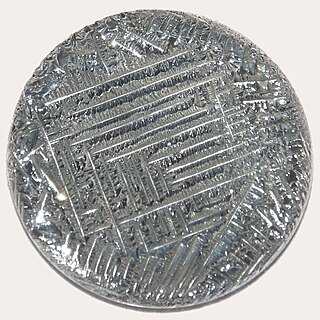
Tellurium is a chemical element with the symbol Te and atomic number 52. It is a brittle, mildly toxic, rare, silver-white metalloid. Tellurium is chemically related to selenium and sulfur, all three of which are chalcogens. It is occasionally found in native form as elemental crystals. Tellurium is far more common in the Universe as a whole than on Earth. Its extreme rarity in the Earth's crust, comparable to that of platinum, is due partly to its formation of a volatile hydride that caused tellurium to be lost to space as a gas during the hot nebular formation of Earth.
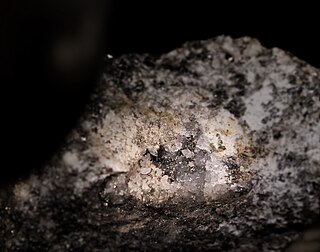
The mineral petzite, Ag3AuTe2, is a soft, steel-gray telluride mineral generally deposited by hydrothermal activity. It forms isometric crystals, and is usually associated with rare tellurium and gold minerals, often with silver, mercury, and copper.

Sylvanite or silver gold telluride, chemical formula (Ag,Au)Te2, is the most common telluride of gold.

Rickardite is a telluride mineral, a copper telluride (Cu7Te5) or Cu3-x (x = 0 to 0.36)Te2. It was first described for an occurrence in the Good Hope Mine, Vulcan district, Gunnison County, Colorado, US, and named for mining engineer Thomas Arthur Rickard (1864–1953). It is a low temperature hydrothermal mineral that occurs associated with vulcanite, native tellurium, cameronite, petzite, sylvanite, berthierite, pyrite, arsenopyrite and bornite.
Weissite is a telluride mineral, a copper telluride. Its chemical formula is Cu
2−xTe. Weissite has hexagonal crystal structure. Its specific gravity is 6 and its Mohs hardness is 3. Occurrence is in Gunnison County, Colorado, Arizona and New Mexico in the United States. It is also reported from Kalgoorlie, Western Australia and Dalarna and Värmland, Sweden.

Jacobsite is a manganese iron oxide mineral. It is in the spinel group and forms a solid solution series with magnetite. The chemical formula is (Mn,Mg)Fe2O4 or with oxidation states and substitutions: (Mn2+,Fe2+,Mg)(Fe3+,Mn3+)2O4.
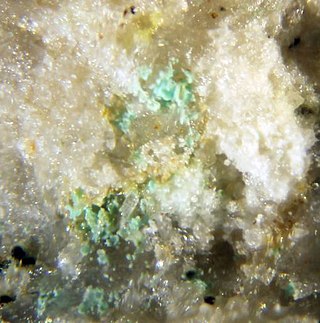
Cesbronite is a copper-tellurium oxysalt mineral with the chemical formula Cu3Te6+O4(OH)4 (IMA 17-C). It is colored green and its crystals are orthorhombic dipyramidal. Cesbronite is rated 3 on the Mohs Scale. It is named after Fabien Cesbron (born 1938), a French mineralogist.

Alabandite or alabandine is a rarely occurring manganese sulfide mineral. It crystallizes in the cubic crystal system with the chemical composition Mn2+S and develops commonly massive to granular aggregates, but rarely also cubic or octahedral crystals to 1 cm.
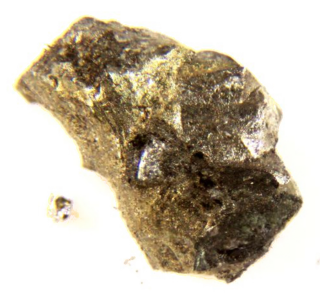
Vulcanite is a rare copper telluride mineral. The mineral has a metallic luster, and has a green or bronze-yellow tint. It has a hardness between 1 and 2 on the Mohs scale. Its crystal structure is orthorhombic.
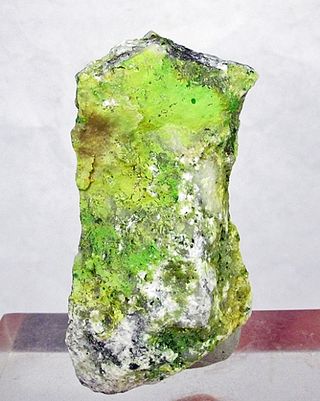
Xocomecatlite is a rare tellurate mineral with formula: Cu3(TeO4)(OH)4. It is an orthorhombic mineral which occurs as aggregates or spherules of green needlelike crystals.

Zemannite is a very rare oxide mineral with the chemical formula Mg0.5ZnFe3+[TeO3]3·4.5H2O. It crystallizes in the hexagonal crystal system and forms small prismatic brown crystals. Because of the rarity and small crystal size, zemannite has no applications and serves as a collector's item.

Walfordite is a very rare tellurite mineral that was discovered in Chile in 1999. The mineral is described as orange with orange-yellow streak, and is determined to have a chemical formula of Fe3+,Te6+Te4+3O8 with minor titanium and magnesium substitution resulting in an approximate empirical formula of (Fe3+,Te6+,Ti4+,Mg)(Te4+)3O8.

Emmonsite, also known as durdenite, is an iron tellurite mineral with the formula: Fe2(TeO3)3·2(H2O). Emmonsite forms triclinic crystals. It is of a yellowish-green color, with a vitreous luster, and a hardness of 5 on the Moh scale.

Stützite or stuetzite is a silver telluride mineral with formula: Ag5−xTe3 (with x = 0.24 to 0.36) or Ag7Te4.

The mineral uytenbogaardtite, Ag3AuS2, is a soft, greyish white sulfide mineral, occurring in hydrothermal Au-Ag-quartz veins. It occurs as tiny crystals, visible only with a microscope. It has a metallic luster and a hardness on the Mohs scale of 2 (gypsum).

Rodalquilarite is a rare iron tellurite chloride mineral with formula H3Fe3+2(Te4+O3)4Cl or Fe2(TeO2OH)3(TeO3)Cl. Rodalquilarite crystallizes in the triclinic system and typically occurs as stout green prisms and encrustations.

Carlfriesite is a rare tellurium mineral with the formula CaTe4+2Te6+O8, or more simplified: CaTe3O8. It has a Moh's hardness of 3.5 and it occurs in various shades of yellow, ranging from bright yellow to a light buttery color. It was named after Carl Fries Jr. (1910–1965) from the U.S. Geological Survey and the Geological Institute of the National University, Mexico City, Mexico. It was previously thought to have the formula H4Ca(TeO3)3, but this was proven to be incorrect. It has no uses beyond being a collector's item.
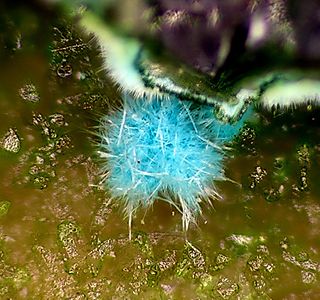
Quetzalcoatlite is a rare tellurium oxysalt mineral with the formula Zn6Cu3(TeO6)2(OH)6 · AgxPbyClx+2y. It also contains large amounts of silver- and lead(II)chloride with the formula AgxPbyClx+2y (x+y≤2). It has a Mohs hardness of 3 and it crystallizes in the trigonal system. It has a deep blue color. It was named after Quetzalcoatl, the Aztec and Toltec god of the sea, alluding to its color. It is not to be confused with tlalocite, which has a similar color and habit.
Teineite is a tellurite mineral with the formula Cu(TeO3). 2 H2O. It has a Mohs hardness of 2.5 and it comes in many different shades of blue, ranging from cerulean blue to bluish-gray. The mineral millsite has the same chemical composition, but crystallizes in the monoclinic system, while teineite crystallizes in the orthorhombic system.
Northstarite is an immensely rare lead-tellurite-thiosulfate mineral with an ideal formula of Pb6(Te4+ O3)5(S6+O3S2-). Northstarite was first discovered in 2019 by Charles Adan in the North Star Mine of the Tintic Mining District, Juab County, Utah, USA. Northstarite received its name after this type locality where it was originally discovered, the North Star Mine. Northstarite is the fourth thiosulfate mineral that exists on Earth, and although all thiosulfates have essential lead components, northstarite is the first thiosulfate species containing groups of both thiosulfate and tellurite (Te4+O3).

















